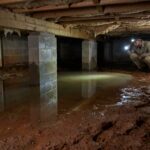Essential Guide to Foundation Repair: Strengthening Your Home from the Ground Up
When you think about the structural integrity of your home, your mind might not immediately go to the foundation. However, it’s arguably one of the most crucial aspects of your house. After all, your beautiful walls, cozy rooms, and lovely rooftop all rely on a solid foundation. Think of your home as an ice cream cone; if the cone is crumbling, all that delightful ice cream is going to end up on the floor. Let’s dive into the essential guide to foundation repair, ensuring your home remains standing tall, stable, and proud.
Understanding Your Foundation
Before we tackle repairs, it’s important to understand what we’re working with. Foundations come in various types: slab, crawl space, and basement. Each has its unique quirks and challenges.
1. **Slab Foundations**: These are common in warmer climates and consist of a single concrete pour directly on the ground. They can be prone to cracking, especially if the soil beneath shifts.
2. **Crawl Space Foundations**: These consist of a small area between the ground and the first floor of your home. This type makes it easier to access plumbing and electrical systems, but moisture can become an issue.
3. **Basement Foundations**: These are built below ground level and provide extra living or storage space. However, they often face issues with water seepage and can be more susceptible to cracks due to hydrostatic pressure.
Each type poses its own set of challenges, so understanding the fundamentals will help you make informed decisions when it comes to foundation repair.
Signs of Foundation Problems
You might wonder if your foundation needs some TLC. Here are some signs that could indicate trouble:
– **Cracks in Walls or Floors**: Hairline cracks can be normal, but if they grow wider or appear suddenly, it’s time to investigate.
– **Uneven Floors**: If you feel like you’re constantly walking on a boat in choppy waters, your floors may be sloping due to foundation settling.
– **Doors and Windows Not Closing Properly**: If your doors start playing hard to get, it might not just be because they’re moody—the underlying support could be shifting.
– **Gaps Between Walls and Ceilings**: If your architectural details start to seem less than seamless, something might be amiss.
Being proactive by identifying these signs early can save you from more expensive repairs down the line.
What Causes Foundation Problems?
It’s vital to understand what might be causing those pesky foundation issues. Here are some common culprits:
1. **Soil Movement**: Soil expands and contracts due to moisture levels, which can lead to shifting foundations.
2. **Poor Drainage**: Water pooling around your foundation can erode soil and create instability. It’s like trying to build a sandcastle during high tide—eventually, something’s got to give.
3. **Tree Roots**: While trees are charming, their roots can wreak havoc on foundations. A maple tree’s aggressive rooting can leave your foundation feeling like it’s been on the wrong end of a wrestling match.
4. **Heavy Structures**: Additional structures, such as porches or garages, can sometimes add stress to your foundation if they’re not properly supported.
5. **Weather Changes**: Sudden weather events, like heavy rains followed by dry spells, can alter the consistency of the soil under your foundation, leading to potential issues.
Foundation Repair Methods
Once you’ve determined that your foundation needs attention, several repair methods can help restore stability. Here are some of the most common options:
1. **Piering**: This method involves installing piers deep into the ground to support the structure. It’s like adding legs to a wobbly table—gives it a solid footing.
2. **Slabjacking**: For slab foundations, this involves injecting a material under the concrete to lift and level it back to its original position. Think of it as giving your foundation a little boost.
3. **Wall Anchors**: For bowing walls, wall anchors can be installed to stabilize them and prevent further movement. It’s akin to giving your walls a supportive hug.
4. **Drainage Solutions**: Installing proper drainage systems, such as French drains or sump pumps, can prevent water damages and mitigate soil erosion issues. You wouldn’t wear flip-flops in a rainstorm, right? Your foundation needs protection too!
Choosing the Right Foundation Repair Company
Not all heroes wear capes—some come equipped with tools and expertise! When seeking a foundation repair company, consider the following:
– **Experience and Reputation**: Look for companies with positive reviews and a history of successful repairs. A good reputation is like gold in the foundation world.
– **Free Estimates**: Many reputable companies offer free assessments. Take advantage of these to get multiple opinions before making a decision.
– **Warranty and Insurance**: Always ask about warranties on repairs. You want to ensure your investment is protected long after the work is done.
– **Credentials**: Make sure your chosen contractor is licensed and insured to protect yourself from liability in the event of accidents.
DIY Foundation Repair: Proceed with Caution
While some minor cracks can be addressed with DIY fixes, such as using caulking or sealant, most foundation repairs require professional intervention. Attempting major repairs without the right knowledge and tools might leave you in a deeper hole—literally and figuratively!
If you do decide to tackle minor repairs, keep the following in mind:
– **Assess the Problem Thoroughly**: Ensure you understand the scope of the issue before diving in.
– **Use Quality Materials**: Don’t skimp on supplies. Choosing inferior materials can lead to problems down the line.
– **Know When to Call for Help**: If the issue seems significant or beyond your expertise, enlist professional help. It’s better to be safe than sorry.
Preventative Measures for a Stable Foundation
Once you’ve repaired your foundation, it’s crucial to take preventive steps to ensure it remains strong. Here are some tips:
– **Maintain Proper Drainage**: Ensure your gutters are clear and direct water away from your foundation. Like a good umbrella, it’s essential to channel water where it won’t do harm.
– **Monitor Landscaping**: Avoid planting large trees too close to your home. Opting for smaller shrubs can save you from future root-related headaches.
– **Regular Inspections**: Schedule regular inspections to catch any new signs of movement early. It’s like going to the doctor for check-ups—better to catch small problems before they turn into big ones.
Conclusion
A solid foundation is the unsung hero of every home, tirelessly supporting everything from family gatherings to unwelcome surprises. By understanding the signs of foundation problems, knowing when to call in professionals, and taking preventative measures, you can ensure that your home remains strong and secure from the ground up.
So, if you ever find yourself facing foundation repairs, remember: addressing issues sooner rather than later can save you money and headache in the long run. Your home deserves a robust foundation, and you deserve peace of mind. After all, who wants a home that feels like it’s ready to do the limbo? Stay proactive, stay informed, and enjoy the stability of your beloved abode for years to come!


